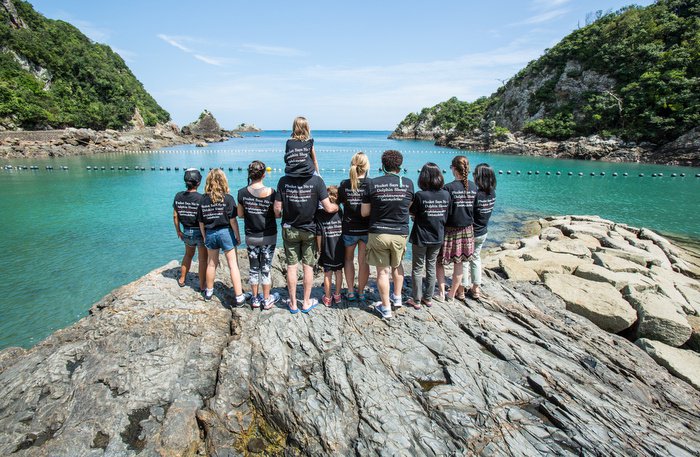The killing cove: ‘Cove monitoring’ in Taiji

PHUKET: On September 11 this year at about 9.35am, Japan time, a young Risso’s dolphin under severe shock and distress tried to escape the hunters by swimming under the enclosing net, only to find itself nearer to the shore instead of out at sea. Swimming straight to where Ric O’Barry stood documenting this horrifying turn of events, the Risso’s pushed itself onto the rocks right by Ric’s feet and, finding no way out, weakly gave up.
The fishermen eventually caught up with the dolphin and roughly pushed it by its tail back into deeper water to get it to swim closer to the killing cove and away from activists’ and reporters’ cameras, but the dolphin simply took its final breath and sank to the bottom of Taiji Cove right before their very eyes.
Although this is the fate of thousands of dolphins each year at this very spot, this particular Risso’s struggle was an extremely tormenting experience for witnesses, not just because it was the first dolphin life sacrificed during this year’s dolphin drive hunt season in Taiji, but also because it proves the extreme cruelty of the drive itself which starts out at sea way before they even reach the notorious cove.
On this day, the slaughter of twelve Risso’s dolphins in Taiji Cove was officially documented. But how many more dolphins actually died without ever being noticed? How many elderly dolphins or babies failed to keep up with the grueling pace of the drive hunt and died of exhaustion in open water?
The real number of deaths of dolphins by Taiji’s brutal drive hunt practice is far more extensive than we could ever imagine, and this barbaric act continues to happen year after year, purely because of the demand for live dolphins to supply marine parks and dolphinariums around the world.
There are many places that hunt and slaughter dolphins in the name of tradition. However, Taiji is practically the only place that captures and sells live dolphins into captivity. For the 2015-2016 season, September through February, Taiji has received more than 150 orders for live dolphins already, each worth an average of US$150,000.
However, what happens to the dolphins that are killed? They are packaged and sold, mislabeled as whale meat for consumption. This is also a sickening practice because dolphin and whale meat is highly toxic with mercury. Eating dolphin meat can lead to mercury poisoning, where the brain and nervous system is affected, causing damage to eyesight, hearing, motor skills, as well as interfering with memory and thought processes leading to dementia. Mercury also attacks fetuses in pregnant women, resulting in severe brain damage.
THE COVE
Only as recently as February this year did I watch the documentary The Cove, and by the time I finished I felt sick to my stomach. The dark side of the small fishing town of Taiji in Japan, whose major attraction is the Taiji Whale Museum, which is a place that celebrates the history of whaling and is a dolphinarium, was the very picture of one’s worst nightmare.
Each year, thousands of dolphins are slaughtered in the cruelest way imaginable just down the road from the museum that has dolphins as its main attraction. The unlucky, yes…unlucky, dolphins however, are captured alive and sold to dolphinariums around the world to live out the rest of their lives away from their family, doing tricks for dead fish, and circling endlessly around tiny pools or sea pens. And the even sadder truth is that the Taiji Whale Museum brokers all the deals.
Recently, the World Association of Zoos and Aquariums (WAZA) stipulated that their members can no longer acquire live dolphins from Taiji. While some marine parks have duly canceled their orders, the Taiji Whale Museum unsurprisingly left the Japanese Association of Zoos and Aquariums (JAZA), a member of WAZA, in order to be able to continue this blood trade.
The Cove star Ric O’Barry, an ex-dolphin trainer turned activist who has committed his life to saving and freeing dolphins all over the world, and his organization, Ric O’Barry’s Dolphin Project (www.dolphinproject.net), enlists volunteers to be cove monitors to document the daily dolphin drive hunts in Japan and raise awareness among the public in hopes of ending this bloodbath and captivity of dolphins.
The film has helped shine a spotlight on the brutality that goes on in Taiji. But while the town has felt increased pressure from external groups to end this practice, rather than having a change of heart, they have instead put the village on even more of a lock down from foreign visitors to guard this not-so-secret secret.
That night, and for many nights to follow, I obsessively watched any videos I could find related to this topic, including Dawn to Death and the film Blackfish. The entire time I was trying to internally process not only the atrocity of it all, but also the fact that my most cherished childhood memories of visiting Sea World Orlando were, in fact, based on loss and suffering of these intelligent mammals.
Then when I heard about the ‘Phuket Says No To Dolphin Shows’ campaign, I jumped at the opportunity to be a part of it. I felt, along with the team, that it is vital that Thai residents and tourists be made aware of the exploitation of dolphins so we can help end this pointless cruelty.
VISITING TAIJI
The decision to visit Taiji was made on the spur of the moment. We, the group of Ric O’Barry Dolphin Project’s cove monitors from Phuket and local volunteers, had only started pushing hard on fundraising and raising awareness in Phuket in July this year. One of the immediate challenges we faced when working with the local community is that most Thais view dolphins as being so far removed from their lives and many did not feel the need to take action when the government and laws seem to condone this act.
We needed to establish that personal connection and demonstrate to people that laws and governments need to change. We decided to go to Taiji ourselves on a personally funded trip. We booked our flights for what we felt was the most appropriate occasion – Japan Dolphins Day and the first day of the drive hunt season in Taiji, September 1.
On August 31, our train took us from Osaka along the coastline to the town of Nachikatsuura, approximately 15 minutes north of Taiji, in Wakayama Prefecture. The jagged rocks and hillside cliffs that meet the sparkling ocean below are simply breathtaking. The Kii mountain range loomed in the background high above the hills and, as we later experienced during our stay there, in the early mornings the fog that floated in the valleys of the mountains high above imitated the gentle swells of the sea below. Everything was seemingly perfect…except for the one dark secret in the nearby town of Taiji.
TAIJI LOGISTICS
Apparently, all foreigners visiting Taiji are required to check in with the police. This does not happen anywhere else that we know of. For us, the process involved getting to the ‘police box’ located on the opposite side of the road from Taiji Cove, handing over our passports for copying, filling out a form with questions about our affiliations and travel plans, and being thoroughly questioned on each and every one of our answers.
This seemingly simple process took nearly an hour to finish. Afterwards, the police knew each of us by name, and most likely had our personal social media accounts up and were surveying them from that point onward.
The box was recently constructed at this location prior to the beginning of this season, most likely so the police could easily observe our ‘activist’ activities. Previously, there was a parking lot there since it is a national park, but the lot has since disappeared.
Later on, we would be told that more than a dozen surveillance cameras had been installed around Taiji town so that the police could see our movements from right inside their box. This meant that we had to be super careful not to violate any traffic laws as well. Something as simple as stopping over the line at a stoplight could have meant our licence being revoked and no more driving in Taiji.
It was more than obvious that these steps had been taken to make sure that our work there was as inconvenient and limiting as possible. The documentary The Cove sure had made enough of a ruckus for the town of Taiji to feel that they have to react at this level.
Driving around town, several unmarked vehicles, just like in the documentary, would follow us from the very moment we cross over the town line. These belonged to local police, state police, and even riot police. There were also reporters and other unidentifiable groups in the mix.
The odd part about this whole situation, though, was that while all these different police officers were there to literally catch us if we ever stepped out of line, in reality they were also there to protect us from anti-activist groups looking to harass us. So although we wanted them to leave us alone and give us room, we were also grateful that they were looking out for us. Things could not be any more mind boggling.
TRAGIC DEATH
Essentially what we were doing in Taiji was to assume the role of a cove monitor. A cove monitor’s day typically began at 4:45am with a 15-minute drive from Nachikatsuura to Taiji Harbor.
From the harbor we would watch and document the twelve drive boats going out before sunrise. We would then position ourselves at Tomyozaki lookout point at the tip of Taiji village where historically the fishermen stood to direct a whale hunt approaching the cove. Looking out onto the horizon, we would try to spot returning boats and determine if they were in drive formation.
A Blue Cove Day where no dolphins are slaughtered is only called when all boats have arrived back at the harbor. If some are still out in the ocean and spot a dolphin pod, other boats in the harbor could still be called back out to finish up the drive hunt.
If dolphins are driven in by the boats, cove monitors would then rush back down to Taiji Cove to film and live-stream the process from there. Such was the case on September 11, where the fisherman finally had their first successful drive hunt of the season and Ric and cove monitors documented the Risso’s tragic death along with the slaughter of all 12 dolphins in that pod just an hour later. It was the first Red Cove Day this year, where the water of Taiji Cove ran red with innocent dolphin blood.
The cove monitor’s work is vital to the awareness raising and campaigning process, for it is virtually the only third-party source of information on the drive hunts available. Without this information, no one would ever know about Taiji and what goes on there daily. The truth would still remain today hidden from the world. Their hard work, sacrifice, and the emotional turmoil they go through is to be commended.
BACK TO PHUKET
Although I was lucky to not have personally witnessed a single slaughter of dolphins while in Taiji, the depressing truth behind the industry that drives this small town could in no way have gone unnoticed. The constant harassment we received from police officers and reporters reminded us every minute that Taiji has something to hide, something shameful in the eyes of the world.
Our reluctant visit to the Taiji Whale Museum, due to an unwillingness to financially support them, but also needed to learn about the history of whaling in Japan and witness for ourselves the true, sad consequences of dolphin captivity, pretty much summed up everything that is wrong with dolphin captivity.
With more than 40 dolphins on their roster, the museum held them in shamefully small tanks and shallow sea pens. These are transient dolphins, as opposed to resident dolphins, and they need to swim hundred of kilometers a day as part of their life, now all captured to be sold, and kept at the museum for training to increase the sales price.
There were as many as six dolphins of mixed species living together in any single pen. These were no bigger than the fishing baskets we have in Thailand.
They were forced to perform for tourists in order to be awarded dead fish. When not performing, they floated about listlessly, swam frantically around in circles, tried to throw themselves onto the platforms, or calling out to visitors for attention. These are all behaviors that are completely unnatural and signal stress and depression as a result of being held in captivity. Many die within a few years of captivity, but are so easily replaceable it is virtually impossible for cove monitors to keep track of when they visit.
Dolphins are intelligent and self-aware. They suffer from pain. When they are ripped apart from their family, they remember that loss and mourn it. Typically, dolphins that are captured are reproductive females and their offspring, or younger dolphins. This means that the pod is then left with elderly dolphins or mourning males, and the stress and shock of seeing their family kidnapped and tortured will most likely kill them too. So the entire pod will eventually, quickly, die out.
Our Taiji experience has left a heavy feeling in the pit of our stomachs and hearts. We cannot let this go on. Upon returning to Thailand we feel we are equipped with knowledge to share, and with inspiration from Ric and cove monitors to help people become more aware.
On September 11, a week after our return, we were given an opportunity to speak to 60 students from Baan Maireab School in Kathu District on this topic. We hope it will be the first of many local schools we will get to visit. We also hope to raise funds to sponsor a Taiji trip later this season for student and community representatives who will become key drivers in raising awareness locally and help to bring about change in Thailand.
‘Phuket Says No to Dolphin Shows’ is a group of volunteers working toward keeping dolphins free in the ocean. We strive to share useful information and facts with government departments and relevant parties in hope that no more dolphins will be imported into Thailand for entertainment purposes, and laws to ban dolphin shows in Thailand will be passed like in England and India.
We are working toward translating the script of The Cove into Thai for Thai audiences. And we plan to continue raising awareness with local students, community members, and tourists via social media campaigns, public messages on various collaterals such as T-shirts and stickers, and face-to-face information sessions and creative activities.
Most importantly, the single most effective action that all of us can do to help end the Taiji slaughter is to not buy a ticket to a dolphin show.
— Thareeya Deasakorn Khamkar
Latest Thailand News
Follow The Thaiger on Google News:


























